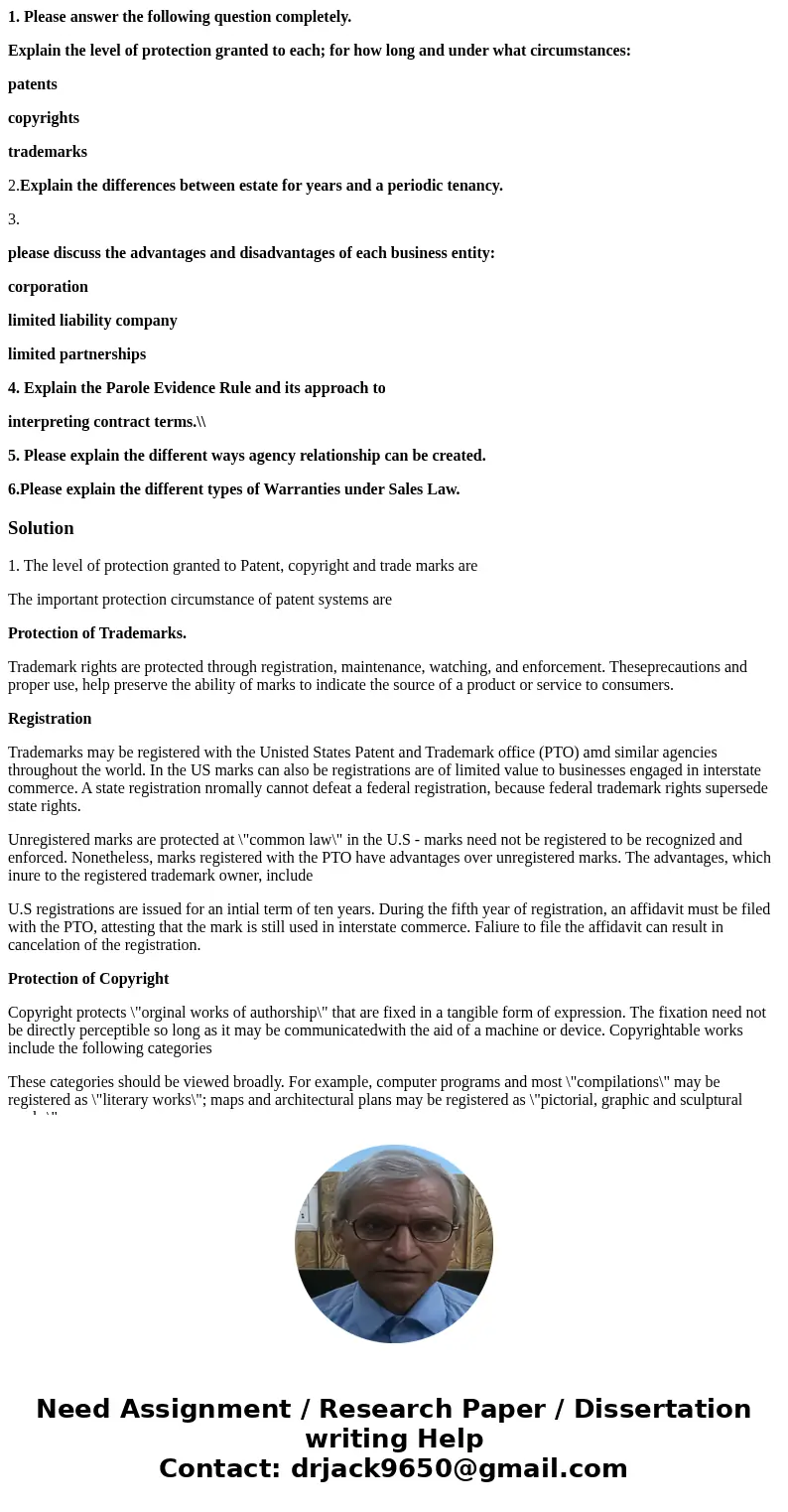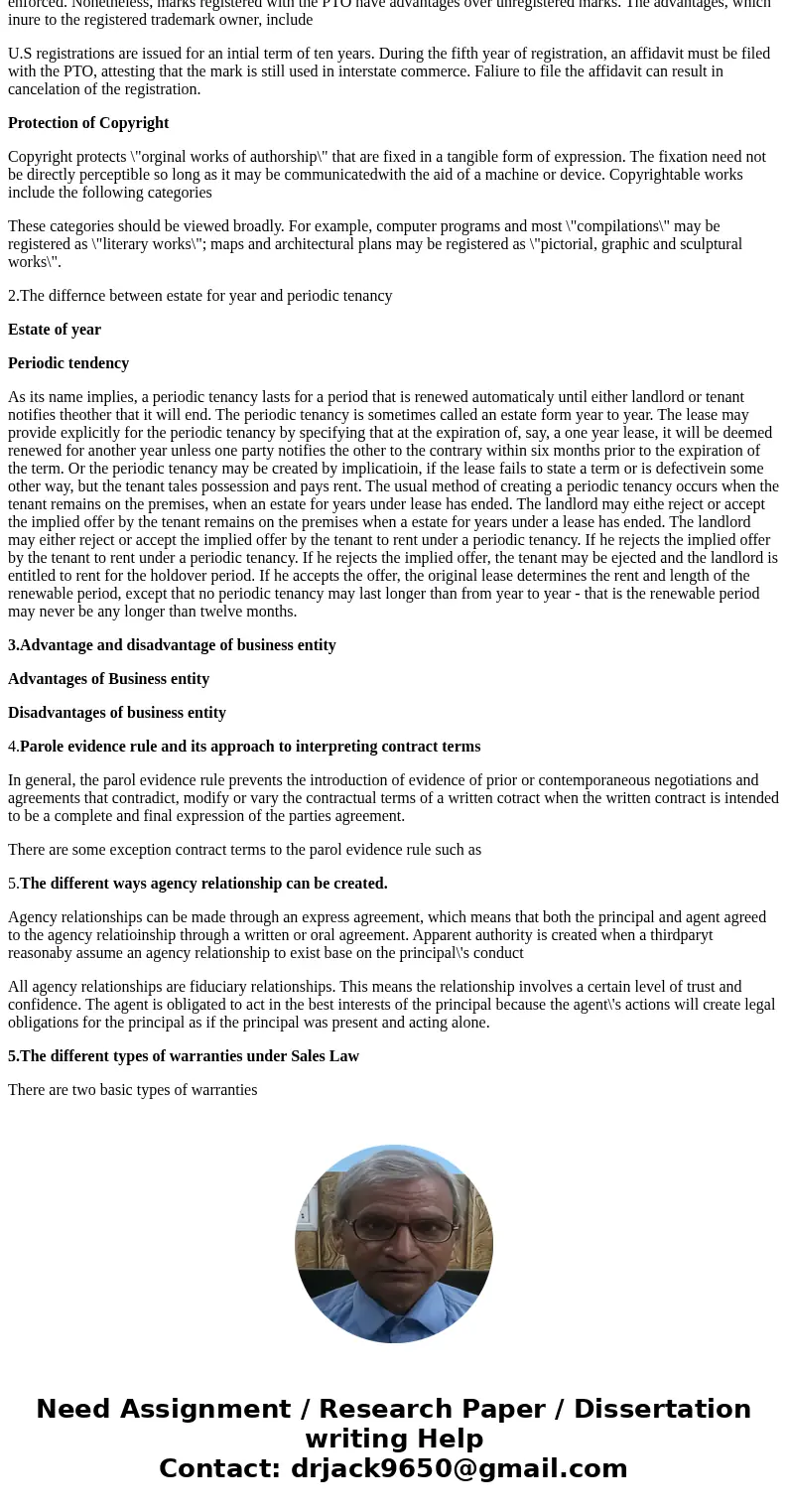1 Please answer the following question completely Explain th
1. Please answer the following question completely.
Explain the level of protection granted to each; for how long and under what circumstances:
patents
copyrights
trademarks
2.Explain the differences between estate for years and a periodic tenancy.
3.
please discuss the advantages and disadvantages of each business entity:
corporation
limited liability company
limited partnerships
4. Explain the Parole Evidence Rule and its approach to
interpreting contract terms.\\
5. Please explain the different ways agency relationship can be created.
6.Please explain the different types of Warranties under Sales Law.
Solution
1. The level of protection granted to Patent, copyright and trade marks are
The important protection circumstance of patent systems are
Protection of Trademarks.
Trademark rights are protected through registration, maintenance, watching, and enforcement. Theseprecautions and proper use, help preserve the ability of marks to indicate the source of a product or service to consumers.
Registration
Trademarks may be registered with the Unisted States Patent and Trademark office (PTO) amd similar agencies throughout the world. In the US marks can also be registrations are of limited value to businesses engaged in interstate commerce. A state registration nromally cannot defeat a federal registration, because federal trademark rights supersede state rights.
Unregistered marks are protected at \"common law\" in the U.S - marks need not be registered to be recognized and enforced. Nonetheless, marks registered with the PTO have advantages over unregistered marks. The advantages, which inure to the registered trademark owner, include
U.S registrations are issued for an intial term of ten years. During the fifth year of registration, an affidavit must be filed with the PTO, attesting that the mark is still used in interstate commerce. Faliure to file the affidavit can result in cancelation of the registration.
Protection of Copyright
Copyright protects \"orginal works of authorship\" that are fixed in a tangible form of expression. The fixation need not be directly perceptible so long as it may be communicatedwith the aid of a machine or device. Copyrightable works include the following categories
These categories should be viewed broadly. For example, computer programs and most \"compilations\" may be registered as \"literary works\"; maps and architectural plans may be registered as \"pictorial, graphic and sculptural works\".
2.The differnce between estate for year and periodic tenancy
Estate of year
Periodic tendency
As its name implies, a periodic tenancy lasts for a period that is renewed automaticaly until either landlord or tenant notifies theother that it will end. The periodic tenancy is sometimes called an estate form year to year. The lease may provide explicitly for the periodic tenancy by specifying that at the expiration of, say, a one year lease, it will be deemed renewed for another year unless one party notifies the other to the contrary within six months prior to the expiration of the term. Or the periodic tenancy may be created by implicatioin, if the lease fails to state a term or is defectivein some other way, but the tenant tales possession and pays rent. The usual method of creating a periodic tenancy occurs when the tenant remains on the premises, when an estate for years under lease has ended. The landlord may eithe reject or accept the implied offer by the tenant remains on the premises when a estate for years under a lease has ended. The landlord may either reject or accept the implied offer by the tenant to rent under a periodic tenancy. If he rejects the implied offer by the tenant to rent under a periodic tenancy. If he rejects the implied offer, the tenant may be ejected and the landlord is entitled to rent for the holdover period. If he accepts the offer, the original lease determines the rent and length of the renewable period, except that no periodic tenancy may last longer than from year to year - that is the renewable period may never be any longer than twelve months.
3.Advantage and disadvantage of business entity
Advantages of Business entity
Disadvantages of business entity
4.Parole evidence rule and its approach to interpreting contract terms
In general, the parol evidence rule prevents the introduction of evidence of prior or contemporaneous negotiations and agreements that contradict, modify or vary the contractual terms of a written cotract when the written contract is intended to be a complete and final expression of the parties agreement.
There are some exception contract terms to the parol evidence rule such as
5.The different ways agency relationship can be created.
Agency relationships can be made through an express agreement, which means that both the principal and agent agreed to the agency relatioinship through a written or oral agreement. Apparent authority is created when a thirdparyt reasonaby assume an agency relationship to exist base on the principal\'s conduct
All agency relationships are fiduciary relationships. This means the relationship involves a certain level of trust and confidence. The agent is obligated to act in the best interests of the principal because the agent\'s actions will create legal obligations for the principal as if the principal was present and acting alone.
5.The different types of warranties under Sales Law
There are two basic types of warranties


 Homework Sourse
Homework Sourse